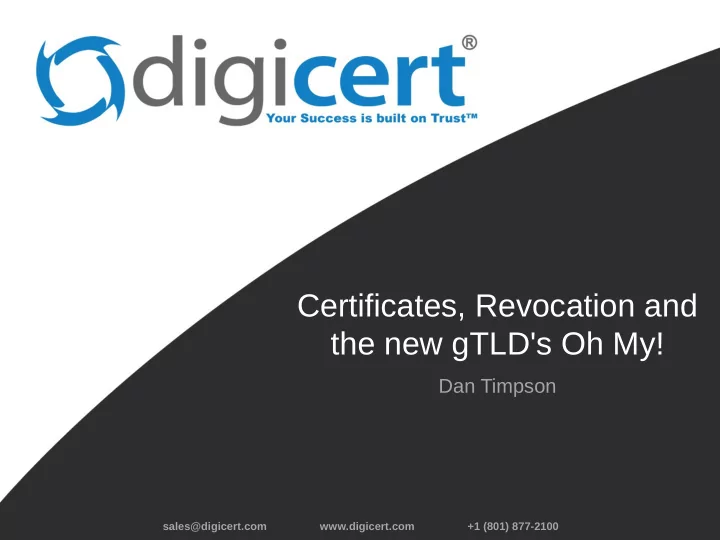

Certificates, Revocation and the new gTLD's Oh My! Dan Timpson sales@digicert.com www.digicert.com +1 (801) 877-2100
Focus ● What is a Certificate Authority? ● Current situation with gTLD's and internal names ● Action taken so far ● Recommendations
What is a Certificate Authority? • CA generates “roots” in secure environment – ceremony, video recorded, audited, keys on HSMs • CA undergoes rigorous third party audit of operations and policy • CA private keys are held under extreme protections and used to sign web site certificates and status information • CA applies for corresponding root certificates to be included into trusted root stores • CA policy and operations must comply with Browser root store rules in order to be trusted by default - distributed by software updates
What is a Certificate Authority? • When issuing a SSL/TLS cert to a web site, the CA verifies certain information relating to ownership of the site with the respective domain and verifies control of keys being used. – This minimal validation is called Domain Validation or DV – While DV certificates verify the consent of a domain owner, they make no attempt to verify who the domain owner really is. • Stronger verification of site and domain ownership and controls for the organizations to which certs are issued allows issuance of higher assurance SSL certificates – This additional validation is called Organization Validation or OV – Additional checks include that they are registered and in good standing with their respective governments etc.
What is a Certificate Authority? • The strongest verification of site and domain ownership with multiple verification of direct contacts etc., allows issuance of the highest standard of assurance for SSL certificates – This highest tier of verification is called Extended Validation or EV – EV issued certs are recognized in browser GUI e.g. green bar
What is a Certificate Authority • CA provides certs ( DV or OV or EV ) to customers chaining to trusted roots embedded in Operating Systems and Browsers • CA Customers (Site Operators) install certs on their servers for secure web pages • Users (clients of CA Customers) go to secure web pages HTTPS:// , User Agent checks for CA’s root inclusion in browser trusted root store • If CA’s root is in browser’s trusted store: encrypted session, favorable padlock UI (including EV green bar)
What is a Certificate Authority • If CA root not in client trusted root store for browser – warning displayed • CAs and browsers have the ability to revoke roots, sub-CAs, and certificates for any problems • CAs publish revocation lists (CRLs) or provide updated certificate status information online (OCSP) • If certificate revoked or expired – warning displayed • CAs must complete annual audits and follow CA/B Forum rules to remain in browser trusted root stores • Stronger rules and higher CA standards are set for green Extended Validations or “EV” display
Revocation info ● All browsers perform some level of certificate revocation checking ● All CA's must provide revocation information via OCSP ● OCSP cache times vary by browser with the longest cache time of 7 days ● OCSP stapling provides OCSP response with the certificate – Most current server distributions support stapling
Background - Internal names ● Prevalent use of internal name certs ● Estimate is ~11,000 certificates issued against internal names ● Common/recommended practice until 2011
Why is this a problem? ● Collisions – Many servers are configured this way – Different experience externally ● Security – Potential for man-in-the-middle attacks – 5 year attack opportunity on organizations with that domain
Action taken so far ● CA/B Forum's original baseline requirements mandated that all internal certs expire or are revoked by 2015 – Based on server operator feedback and businesses ● Roadblocks include policy, cost and training ● CA/B Forum approached by ICANN – CA/B Forum passed a ballot – Feb 20, 2013 – Accelerates the deprecation from 5 years down to 120 days after the relevant gTLD contract is published. – 120 days is required for large volumes (Top 10%) ● Mozilla.org has adopted the revised requirements – July 31 st All CA's must comply to remain in the trust store
Action taken so far ● CASC – Was formed by CA's to improve education, marketing and research – Information on OCSP stapling – Reconfiguring servers with public FQDN's ● Avoiding Collisions – Digicert and other CA's are actively working to migrate customers off internal names ● Communicating with customers ● Only solves training doesn't reduce cost ● Digicert Internal Name Tool
Recommendations for ICANN ● Don't approve the names that are most commonly used in internal certs until 2015 – Digicert Letter (.corp gTLD) – PayPal letter ● Approve the application but delay the delegation until 2015 ● Remaining 90% can move forward with minimal impact ● Security issues with certs is effectively resolved
Recommend
More recommend